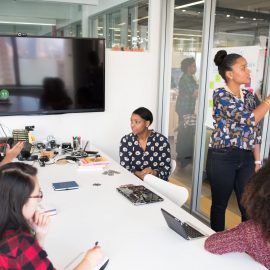

This article gives you a glimpse of what you can learn with Shortform. Shortform has the world’s best guides to 1000+ nonfiction books, plus other resources to help you accelerate your learning.
Want to learn faster and get smarter? Sign up for a free trial here .
Why do people get embroiled in cyclical conflicts—both on a large and a small scale? Why do people often resist a resolution? Is a mutually beneficial resolution always possible?
We all struggle with conflicts, both on a smaller scale—in our businesses and families—and on a grand scale—politically and intergovernmentally. In all spheres of our lives, we see people embroiled in bitter, cyclical conflicts that appear to resist all efforts toward resolution. If we can learn how to handle conflicts more productively, our personal relationships and the world at large will be a better place.
In this article, we’ll discuss three conflict resolution methods that will work in any situation, from small-scale disagreements to large-scale arguments.
Conflict Resolution Methods
When it comes to conflict—no matter its scale—there’s always a solution. It might be a mutually beneficial resolution, a compromise, or a concession on one party’s end. However, people often don’t see (or are unwilling to reach) a resolution for various reasons: pride, grudges, and the unwillingness to acknowledge that they are part of the problem.
Moreover, conflict incites heated emotions, which cloud perspective and escalate the situation. With this in mind, the keys to effective conflict resolution are following a systematic approach and keeping a cool head.
1. The Strategy of Peace (Arbinger Institute)
Most people resolve conflict by trying to fix what’s going wrong rather than preventing it from going wrong in the future by addressing the underlying issues that have led to the conflict in the first place. This is a top-bottom conflict resolution method.
According to the Arbinger Institute, there are two main problems with the top-bottom conflict resolution method:
- It’s not helpful to correct someone who’s upset with you because they don’t want to listen. They’ve already decided you’re wrong, so even if you feel their reasons are foolish or invalid, arguing with them doesn’t help.
- You’re trying to correct things that have already gone wrong instead of being proactive and preventing them from going wrong in the first place.
The Institute discourages prioritizing correction because when you aim for the nail that sticks up, you miss the factors that pushed the nail out in the first place. Taking drugs away from a teenage addict won’t prevent them from accessing more, but a stronger support network and a more loving home might neutralize their need for drugs in the first place.
Instead, Arbinger Institute recommends a bottom-up conflict resolution method that focuses on addressing the factors that have led to the behavior as opposed to correcting the behavior itself. According to Arbinger, this requires that you adopt a “cooperative mindset.”
Resolving Conflict From a Cooperative Mindset
Arbinger Institute distinguishes between two mindsets of conflict resolution: the combative mindset and the cooperative mindset. When we embody the combative mindset, we view others according to how they affect us. When we embody the cooperative mindset, we see the person behind the other’s words and actions.
The key premise of the Arbinger’s conflict resolution method is to adopt the cooperative mindset by identifying and removing the biases that trap us in the combative mindset, rethinking the situation from an unbiased perspective, and then acting on your conscience. Once you’ve considered the situation from an unbiased perspective (as opposed to your original, one-sided perspective), your conscience will prompt you with a new sense of what’s right—one that takes both perspectives into account.
The core of the cooperative mindset is the choice to see those around you as people, to be curious and interested in their needs, burdens, and struggles, and to act on your internal sense of how to treat them well. When you do that and maintain it, you become an agent of peace, a voice that—even in conflict—pushes for a cooperative solution instead of an escalating war.
Your goal, as an outward-focused person—a person who consciously resists dehumanizing and objectifying others—is to build resilient, cooperative relationships. Such relationships enable you to correct the problematic behavior of others in a way that is considerate and respectful, and that will be received gracefully and without resistance.
This strategy can be visualized in the form of the Influence Pyramid:
Its bottom-up structure conveys the following lessons:
- Success in the upper stages depends on your investment in the lower areas; your ability to fix what’s wrong is generated by your dedication to helping things go right.
- The solution to a problem at one level is always below that level.
- Your effectiveness on any level depends on your mindset; your dedication to seeing others as people and treating them as such.
If you find yourself in conflict with someone, or if you’re working with or living with a person with whom you’d like to either avoid conflict entirely or proactively mitigate it, build the Influence Pyramid:
1. First, maintain a cooperative mindset. Get out of the box and stay out of the box. Everything that follows is predicated on this and will only be possible insofar as you’re not in a box.
2. While you’re out of the box, build relationships with those who have influence with the person you want to connect with. If that’s your child, build your relationships with the other parent, with their friends, and with their teachers. If it’s a coworker, build your relationships with their superiors, their subordinates, and their peers. The friend of your friend is your friend; in showing respect and consideration for the people they love, you show respect and consideration for them.
3. Next, work on building the relationship with the person you want to connect with. Stay out of the box as you spend time with them. Find out what they like to do, and do it with them. Be involved, be interested, and be engaged. Give them a judgment-free space where they can be genuine, and show them that you value their openness. Trust them, and show them that they can trust you.
4. As your relationship grows, be sure that you’re listening to them, that you’re learning from and about them. What are their burdens, struggles, and pains? What are their hopes, dreams, and goals? The more open you are with them—the more you stay out of the box—the easier it will be to do this. As you learn, you may find that there are things you need to change about the way you’re seeing them, the way you’re evaluating the problems you face in your relationship, and the way you’re behaving. Take these opportunities to reevaluate your strategy and adjust as needed.
5. At this stage, you can begin teaching what you know. By listening and learning you’ve mitigated the possibility that you’ll focus on lessons that aren’t appropriate to the other party’s needs. Your understanding of who they are and what they’re going through will show you where they need help and how you can be involved. The atmosphere of trust and communication you’ve built will foster a desire to learn from each other and cooperate with each other. You can teach your mindset, share your experience, and demonstrate what you’ve learned. You can show them why change is important and how it can help them.
6. Finally, if necessary, correct. Because of the way you’ve built the relationship, you can suggest behavioral and mindset changes from a position of trust and care. They’ll be more open to receiving guidance and feedback, and they’ll understand that your goal will always be to cooperate and learn from each other.
If you find that the correction isn’t working, return to the previous steps. Make sure you’re out of the box toward the other party, that you’re building relationships with the people who have influence over them, that your relationship with them is strong. Continue to be curious and interested in their needs, struggles, and goals. Foster an environment in which they can share those needs with you. Make sure they understand why it’s important for them to reevaluate their behavior. Check to make sure that you’re not missing or misunderstanding something, that the change you’re asking for is genuinely good for them, and then try again.
This is the conflict resolution method that leads to long-term resilient resolutions. It’s the path that opens up to us when we choose to embody the cooperative mindset. You’ll still find yourself in conflicts, and you’ll still find that many other people choose the combative mindset and resist your efforts to collaborate toward resolution. But when you embody the cooperative mindset, your mindset will invite them to reevaluate. You won’t be contributing to the problem, so it’ll be less likely that a conflict becomes cyclical and destructive.
TITLE: The Anatomy of Peace
AUTHOR: The Arbinger Institute
TIME: 43
READS: 59.2
IMG_URL: https://www.shortform.com/blog/wp-content/uploads/2021/05/the-anatomy-of-peace-cover.png
BOOK_SUMMARYURL: the-anatomy-of-peace-summary-the-arbinger-institute
AMZN_ID: XYZ
2. The NVC Method
The key premise of the NVC conflict resolution method is that behind every conflict are unmet needs. Identifying the unmet needs underlying the conflict helps you empathize with the other person because human needs are universal.
Effective conflict resolution requires that people on both sides of the conflict come to appreciate that their own needs and the other person’s needs are equally important. Therefore, the goal of the NVC conflict resolution method is not compromise. In a compromise, neither party’s needs are fully met, and those remaining unmet needs will only cause further problems down the road. The NVC conflict resolution method is about finding a way to resolve conflict in a way that meets the needs of all parties.
The 5 Steps of NVC Conflict Resolution
As you go through the NVC conflict resolution process, the key thing is to focus on giving everyone a chance to express their needs before moving on to solutions. Therefore, the first steps are to understand the unmet needs of all parties involved. In total, there are five steps:
Step 1: Express your own needs.
- Be careful to differentiate between needs and strategies. For example, the statement “I need you to leave me alone for a minute” is a strategy, not a statement of need, because it references someone doing something. A true statement of need would be, “I’m feeling overwhelmed and I need to rest for a minute.” It’s sometimes difficult to tell needs and strategies apart because we’re not used to openly and vulnerably sharing our needs.
Step 2: Identify the other person’s needs (this step can also be done first).
- If the person you’re communicating with isn’t practicing NVC, they might express their needs in more indirect ways. Silence, rejection, and judgmental comments are all veiled statements of need. By recognizing these and translating them, you can keep the conversation flowing nonviolently even if the person you’re talking to isn’t using NVC.
Step 3: Verify that both of you accurately understand each other’s needs by repeating the other person’s needs back to them and asking them to do the same for you.
Step 4: Provide empathy by focusing on their unmet needs.
Step 5: Propose strategies that meet everyone’s needs.
- Propose solutions using present language by requesting what you need in this moment in order to move forward. This gives the other person the chance to either agree or refuse right in the moment. For example, ask, “Would you be willing to tell me if I can borrow your car tomorrow?” instead of “Can I borrow your car tomorrow?”
TITLE: Nonviolent Communication
AUTHOR: Marshall B. Rosenberg
TIME: 41
READS: 105.6
IMG_URL: https://www.shortform.com/blog/wp-content/uploads/2021/05/nonviolent-communication-cover.png
BOOK_SUMMARYURL: nonviolent-communication-summary-marshall-b-rosenberg
AMZN_ID: XYZ
3. The Difficult Conversations Method
Conflict often arises due to differences in perception, in which case, the only truth is that there’s no truth. Both parties have their own “stories” that make perfect sense to them, but the stories are in conflict. When people focus on arguing their own “right” story, they lose the opportunity to explore the other person’s story and understand why they think they’re right.
How Our Stories Get Built
- First, we all take in information. But there’s so much information to take in that we can only take in a fraction of what’s being offered to us in a given moment—what we take in can be vastly different from what another person takes in, even if they’re sitting right next to us.
- Secondly, after we take in what information we can, then it’s up to our brains to interpret what that information means. This is yet another fork in the road where people can diverge.
- Two factors that influence how we interpret information are 1) our past experiences and 2) the rules we learned about how things should or shouldn’t be done.
- People’s actions and why they make sense only make sense in the context of their past. All our strong views are extremely influenced by our past experiences, and what we learned from our family or other early influences.
- Usually, we’re unaware of just how much our past affects our present interpretation and judgment of information.
- Our past experiences lead us to different conclusions that become “rules” to live by—the shoulds or shouldn’ts that get us into trouble in arguments. Difficult conversations occur when two people’s rules clash.
- However, our conclusions and rules usually reflect self-interest: they support our view and interpret the information favorably based on our conclusions.
- Lastly, we draw conclusions about the information we’ve gathered and how we’ve interpreted it, and we make judgments.
Only we have access to our past experiences and information that form our conclusions. We know ourselves better than anyone else knows us. So we should assume that other people know themselves better than we could ever hope to. We shouldn’t assume that we know what others’ stories are or how others’ stories were built. We should aim to understand each other’s stories enough to see how the opposing perspective also makes sense. Understanding alone won’t solve the issue, but it’s the first step toward actually getting to a resolution.
Test Your (Differing) Hypotheses
Once both parties’ stories have been heard, the next step is to come up with some test options that might help solve both sides’ issues.
At this stage, it’s important to identify the underlying assumptions that the differences in perspective stem from. We usually keep these assumptions to ourselves, or we might not even know they’re assumptions. If you can identify what the conflicting assumptions are, then you can come up with a fair test to see whose assumption is more valid, or how much more valid it is.
For example, your neighbor’s dog has been keeping you up with his barking. You talk to your neighbors and discover they just had a baby and have been keeping the dog outside at night because they’re afraid he’ll hurt the baby. It’s not a fair test to propose they get rid of the dog—it only really addresses your issue. It could be a fair test, however, to propose keeping the dog inside for a few nights and shutting the door to the baby’s room, which addresses both parties’ issues.
TITLE: Difficult Conversations
AUTHOR: Douglas Stone, Bruce Patton, Sheila Heen
TIME: 46
READS: 34.1
IMG_URL: https://www.shortform.com/blog/wp-content/uploads/2020/01/difficultconversations-cover.jpg
BOOK_SUMMARYURL: difficult-conversations-summary-douglas-stone-bruce-patton-sheila-heen
AMZN_ID: B004CR6ALA
Final Words
Conflict is inevitable from time to time. But conflict can actually be a good thing because it presents an opportunity to negotiate individual differences. The problem is that people tend to get fixated on their own perspectives so much that they lose sight of the bigger picture.
As the discussed conflict resolution methods empathize, the key prerequisite for effective conflict resolution is to step back a little and consider the other person. Where does their stance in the conflict stem from? What are the needs and struggles behind it? And what are the underlying assumptions behind the parties’ differences in perception?
The shift in perspective is not a resolution in itself, but it’s a necessary foundation for it. Even if only one party makes this shift, it’s a step in the right direction. From there, reaching a resolution is a matter of testing different options that solve both sides’ problems, or at the very least, agreeing on a compromise.

Want to fast-track your learning? With Shortform, you’ll gain insights you won't find anywhere else .
Here's what you’ll get when you sign up for Shortform :
- Complicated ideas explained in simple and concise ways
- Smart analysis that connects what you’re reading to other key concepts
- Writing with zero fluff because we know how important your time is






